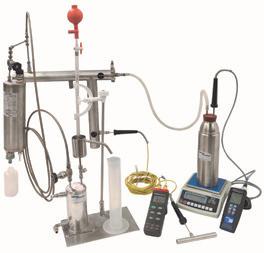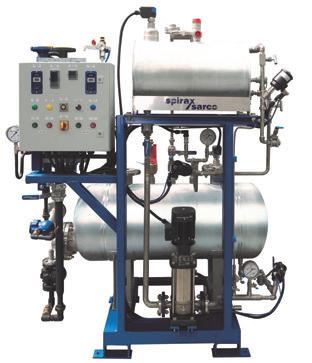
6 minute read
News
FULL STEAM AHEAD
THE ANSWER FOR STERILISATION AND THERMAL LOADS
In more recent issues, we have discussed the benefits of clean steam for sterilisation and how this helps provide security for sterile loads within CSSD however in this issue we will explore the wider energy benefits when considering the system as a whole.
To re-cap, it all boils down, excuse the pun, for the need of heat energy. Traditionally this energy has come from the combustion of fossil fuels but, as it is not practical to light a fire under every process that needs heat energy, steam becomes an ideal medium as it retains a large volume of heat energy relevant to its mass, gives up its energy when condensing and can be transported easily (i.e simply via pressure drop).
As we pointed out in volume 43, the desire to move away from fossil fuels is constantly evolving however this doesn’t disclude the fact that steam itself remains the most efficient energy carrier. What changes is the way its generated and how its utilised. Often it’s thought an alternative means for heat generation can be via electricity however the infrastructure required to generate and supply (both transmission and distribution within a HSO facility) in comparison would be immense. In addition if the power grid supplying a HSO is still generated by fossil fuels, then the question is posed, “how does this change anything”. Its just adds more load to the grid, not reduce it.
The combustion of fuel to provide energy to thermal processes will continue to be a key consideration, but this is not to say that it cant be done in a renewable fashion. Biomass and hydrogen are possible renewable energy sources that are in the not too distant future and in the mean-time, locally steam systems can be made more efficient by focussing on energy recovery and utilising the thermal capacity of the plant to service as many energy using assets as possible, reducing the need for other energy sources. This can be in combination with site based renewables such as solar and or co / tri-generation.
The basics still have their place, improving condensate return volumes, recovering energy from flash or low pressure sources and considering high efficiency burners for steam generation are all widely available however what of other waste heat streams. Hot flue gasses, compressors, chillers, solar and even hot effluent can be considered a potential source of thermal exchange, recovering energy and saving on thermal loads in other areas of the hospital.
In summary, there are many ways of creating a thermally efficient, sustainable and economical steam plant whilst not compromising on the evolving need for improved sterility and repeatability of the sterilisation process. Using steam as the energy transporter remains the universal choice for meeting the a HSO’s thermal needs, we just need to be smarter on how heat is re-captured and utilised. As always, we must continue to measure and monitor our energy intensity in order to justify and uncover energy saving opportunities in a HSO and as thermal generating sources become more advanced, will ultimately improve environmental sustainability. Regardless steam remains relevant and should be part of a evolving HSO’s infrastructure. https://www.spiraxsarco.com/global/en-AU/contact-us
Figure 1 – A modern steam plant layout
Figure 2: A General overview for Steam utilisation in a Hospital

healthcare solutions

Clean Steam Solutions Steam Quality and Purity Testing Steam Systems Optimisation Instantaneous Hot Water Generation Steam System Services

Steam System Audits | Installation & Commissioning | Service & Repair
For more information contact Spirax Sarco on 1300 774 729 (SPIRAX) or info@au.spiraxsarco.com
EasiHeat™ Instantaneous Hot Water Generation AH-CSG Clean Steam Generator



Steam Quality Testing
MTA COOLING SOLUTIONS FOR MEDICAL TECHNOLOGY
MTA cooling systems are widely applied within modern medical facilities, specialising in imaging and oncology technologies, for the cooling of MRI, LINAC and PET machines. MTA SpA have been focused towards product development to meet the upcoming ERP2021 energy reduction program for Europe as well as meeting local energy benchmarks in Australia.
Key development areas for the MTA range of air-cooled water chillers include:
TAEevo Tech:
This range of scroll compressor air-cooled process chillers now covers nominal cooling capacities between 8 to 259 kWr as well as introducing key energy saving technologies such as electronic expansion valves, variable speed condenser fans and oversized condensers to reduce compressor discharge pressures and increase maximum ambient run temperatures.
Aries Tech 2:
Complete redesign of the Aries Tech scroll compressor air cooled chiller range.
Now offering nominal cooling capacities of 162 to 945kWr, this range now comes as standard with shell & tube evaporators, V configuration condenser coils, optional internal chilled water buffer tanks with choice of single or dual water pumps. This range also provides a choice on refrigerant type, standard with R410A or option of a lower GWP refrigerant, R545B. For further details on the MTA product range visit our website www.mta-au.com or contact us on 1300 304 177 / email sales@mta-au.com.

EFFECTIVE LIFE CYCLE PLANNING
As the health care sector emerges, cautiously, from the pandemic enforced lock down, stiff competition from core business for increasingly constrained budgets is likely to be the order of the day.
In this environment a major challenge for healthcare engineers will be securing support for asset replacement projects. It has always been the case, understandably, that business cases for the replacement of non- core assets such as chillers and boilers are much more difficult to make than those for the replacement of core business assets.
Of course there are many reasons for this that include: • It is difficult to make the case that an asset requires replacement when it appears to be operating effectively; • Engineering assets often fail in service gradually and stakeholders get used to ‘living with’ the inconvenience of unreliable operation- making it difficult for the need to replace them to be perceived; and, • Key decision makers typically have a better understanding of the need for core business assets than they do for non- core business assets.
Faced with these challenges a number of healthcare engineers are turning to RMIT’s CAMS life cycle modelling tool to help communicate their long term asset replacement needs to senior management. Developed over the last twelve years by PhD students using a range of statistical analytical tools, a suite of 900 curves have been developed that model asset degradation over time. These curves are initially applied at individual asset level. CAMS then uses a self- learning algorithm informed by asset condition data, that is uploaded over time, to model how each individual asset is deteriorating in the field.
Asset data can be analysed and reported at both micro and macro level, assets can be classified in any way the client specifies, for example from the point of view of risk, priority or asset type.
Key to CAMS’s success has been the ability to present technical data about asset life in a way that is intuitive to senior management from a non- technical background.
A large number of healthcare organisations, throughout the country have found success in deploying CAMS and see it as an essential tool in planning asset replacement activities. Helping to prioritise these works over time and to manage the expectations of senior stakeholders. Particularly when planning major items of future capital expenditure.
For further details please visit our website www.macdonaldlucas.com










